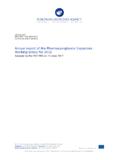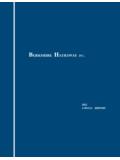Transcription of Global FORCED Trends DISPLACEMENT IN 2017 - …
1 GlobalTrendsFORCED DISPLACEMENT IN 20172017 in ReviewTrends at a million million internally displaced million refugees under UnHCr s million Palestine refugees under UnrWa s million asylum-seekersas a result of persecution, conflict, or generalized Million newly displaced An estimated million people were newly displaced in 2017. This included million individuals displaced2 within the borders of their own countries and million newly displaced refugees and new Developing regions hosted 85 per cent of the world s refugees under UNHCR s mandate, about million people. The least developed countries provided asylum to a growing proportion, amounting to one-third of the Global total ( million refugees).
2 1 in 6 Lebanon continued to host the largest number of refugees relative to its national population, where 1 in 6 people was a refugee under the responsibility of UNHCR. Jordan (1 in 14) and Turkey (1 in 23) ranked second and third, respectively. When Palestine refugees under UNRWA s mandate are included, the figures rise to 1 in 4 for Lebanon and 1 in 3 for displaceMents everY daYThe number of new displacements was equivalent to an average of 44,400 people being FORCED to flee their homes every day in asylUM-seeKeRsBy the end of 2017, about million people were awaiting a decision on their application for asylum, about half in developing , the forcibly displaced population increased in 2017 by million.
3 By the end of the year, million individuals were forcibly displaced worldwide as a result of persecution, conflict, or generalized violence. As a result, the world s forcibly displaced population remained yet again at a record Internal DISPLACEMENT Monitoring Centre of the Norwegian Refugee The number of new individual asylum applications for Turkey does not include Syrian nationals who receive protection under the Temporary Protection ,4002 UnHCR > Global Trends 2017102,800 RefUgees foR ResettleMentin 2017, UnHCR submitted 75,200 refugees to States for resettlement, a 54 per cent drop from 2016 due to the decline in resettlement quotas.
4 According to government statistics, 102,800 refugees were admitted for resettlement during the year, with or without UnHCR s assistance. 173,800 UnaccoMpanied and sepaRated childRenThis conservative estimate takes into account new applications, asylum-seekers and refugees. it includes 45,500 unaccompanied and separated children who sought asylum on an individual basis in 2017 as reported by 67 countries and 138,700 unaccompanied and separated child refugees and asylum-seekers as reported by 63 UnHCR operations, with reductions to avoid possible childRenChildren below 18 years of age constituted about half of the refugee population in 2017, up from 41 per cent in 2009 but similar to more recent rep.
5 Of the CongoThe IDP population in the Dem. Rep. of the Congo doubled in 2017 to million. Also, 620,800 Congolese refugees in other countries and 537,100 refugees from other countries in Dem. Rep. of the Million displaced people RetURned During 2017, nearly 5 million displaced people returned to their areas or countries of origin, comprising million internally displaced people and 667,400 refugees. Returns have not kept pace with the rate of new displacements. 68% Altogether, more than two-thirds (68 per cent) of all refugees worldwide came from just five countries: Million new claiMsAsylum-seekers submitted million new asylum claims.
6 With 331,700 such claims, the United States of America was the world s largest recipient of new individual applications, followed by Germany (198,300), italy (126,500), and Turkey (126,100). peopleFor the fourth consecutive year, Turkey hosted the largest number of refugees worldwide, with million people. The main countries of asylum for refugees were:Syrian Arab Republic millionSouth Sudan millionMyanmar millionSomalia986,400 Turkey millionPakistan million Uganda millionLebanon 998,900 Islamic Rep. of Iran 979,400 Germany 970,400 Bangladesh 932,200 Sudan 906,600655,500 refugees displaced to Bangladesh in 2017, mostly in 100 days since end of August.
7 Myanmar3unhcr > Global Trends 2017chapteR 1 IntroductionMultiple ongoing DISPLACEMENT crises and several new ones characterized 20 1 7. As a result, the Global population of forcibly displaced people increased to million, compared with million in 2016. Significant new DISPLACEMENT , affecting millions of people, was seen in particular from the Democratic Republic of the Congo (DRC) and Myanmar as well as continuing DISPLACEMENT due to the Syrian crisis. The past decade has seen substantial growth in the Global population of forcibly displaced people. In 2007, this population numbered million; over the last 10 years, this figure has increased by over 50 per cent [figure 1].
8 4 Today 1 out of every 110 people in the world is displaced, compared with 1 in 157 a decade ago, with much of this increase having occurred over the last five While the Syrian conflict contributed significantly to this increase, there have been other major displacements throughout the world over the last five years, notably in and from Burundi, Central African Republic, the DRC, Iraq, Myanmar, South Sudan, Sudan, Ukraine, and These included million refugees: million under UNHCR s mandate and million Palestinian refugees registered with the United Nations Relief and Works Agency for Palestine Refugees in the Near East (UNRWA).
9 The Global figure also included million internally displaced persons (source: IDMC) and million individuals whose asylum applications had not yet been adjudicated by the end of the reporting period. 5 The annual rate of change of the population of forcibly displaced in the first five years of the last decade was per cent, while for the last five years it was per cent per year on average. We are at a watershed, where success in managing FORCED DISPLACEMENT globally requires a new and far more comprehensive approach so that countries and communities aren t left dealing with this alone.
10 Filippo GrandiUnited nations High Commissioner for refugees4unhcr > Global Trends 2017banGladesH. An eight-year-old Rohingya refugee girl stands beneath a UNHCR solar lantern outside her shelter at Kutupalong camp in Bangladesh. "I feel happy to have light; it helps me to study," she says. Newly arrived families receive solar lanterns as part of their emergency relief package. UnHCR/AnDRew MCCOnneLL5unhcr > Global Trends 2017 The levels of new displacements in 2017 continued to far outstrip any returns or other solutions. During the year, million people were newly displaced, including million who sought protection abroad6 and million who were FORCED to flee but remained in their own in 2017 an average of some 44,400 people were newly displaced every day [figure 2], a higher rate than seen even in 2014.














